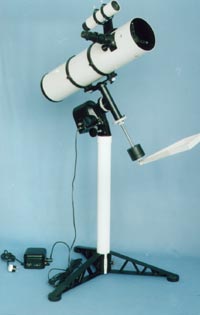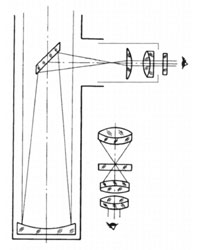Main / Catalog / Telescopes / Newtonian 6" TAL-150P, TAL-150PM Telescope
This classic 6-inch (150mm) aperture Newtonian reflector has a fast focal ratio of f/5 to permit astrophotography of nebulae, galaxies, and star clusters with modest exposure times. However, performance at high magnifications on the Moon and planets is not compromised thanks to an exquisite parabolic primary mirror of 1/10-wave surface accuracy. A classic design, it features a seamless aluminum tube with fully adjustable precision mirror cells and a 4-vane spider, a rack-and-pinion focuser with an elegant clamping ring that holds eyepieces firmly without marring their barrels, and a 8x50mm finderscope with 6-point thumbscrew alignment.
The TAL-150P is supplied with an equatorial mounting equipped with slow-motion controls on both axes, a rock-steady metal pedestal; two 1.25-inch Plossl eyepieces of 10mm and 25mm focal lengths; a 2x Barlow lens; a set of solar, lunar, and color filters; and an adaptor for 35mm SLR cameras. The TAL-150PM model also includes a an enclosed worm-and-wheel motor drive in Right ascension for effortless tracking of celestial objects under observation..
You'll find both the TAL-150P to be versatile, highly portable, and very easy and comfortable to use. Complete - no "extras" to buy! Shipped in a sturdy wooden container.
Luis Balanzino's question:
TAL-150P. Interesting scope, I like the aperture, moderate size, the superb finder, the price, but is difficult to obtain much information about this model. I only know few users of it and they spoke well about it, but to be honest, I'm very cautious about "fast" Newtonians. I know they're harder to collimate, they need better EPs, the central obstruction is larger (=less contrast), and I would prefer to spend my time observing instead of collimating. Probably good for deep sky, but what about planets and double stars?
Hal Newton's answer:
I have the TAL150PM. This is a 6" motorised eq mount Newtonian at f5. I LOVE this scope. I have used it to identify all 7 of the visible moons around Saturn, and this is not trivial. One of the moons is a magnitude 12.5, so finding it requires good optics at 6" aperture.
Collimation is simple - ONCE YOU REALLY UNDERSTAND! It stays collimated very well if you don't bang it around. I transport mine in a car regularly and the collimation stays put, but I don't let it roll around. I can clearly identify the Cassini division in SaturnБ─≥s rings, and am currently studying Saturn to see what else I can see. Albireo looks great, comes in gold and blue just as it should. The ring nebula looks great.
The notion that a fast newt is not a good planetary scope is pure foolishness. Eyepiece choice is more critical in that you'll want eye relief, but you can certainly stack barlows and accomplish the task. The images are great.
I don't understand anyoneБ─≥s hesitation in purchasing the 150PM. (I wouldn't buy it without the motor.) You can always make a fast scope magnify to the slow scope scale, but you can't get the field of view of the fast scope into the slow one. The TAL 150 optics are top of the line, so the choice is simple -- go fast.
In short, forget the f8 and slower scopes, they don't offer anything that you can't get from the f5, and the f5 offers things that the slow scopes can't deliver.
Dave Gibbons's (UK) opinion:
So out we go last night let the scope cool down for an hour target Jupiter stick in the 10mm Plossl and hope for the best - Wow pretty good ! Image is sharp and bright belts are in evidence- right now stick in 2x barlow and 10 mm eyepiece - Double wow the planet is superb at belts are showing a wealth of detail much better than the 8" celestron sct I used to own. I move on to Saturn again excellent image both bright and sharp Ring division easily shown along with some surface details. The scope seems to handle high magnification very well- great barlow eyepiece.
So first impressions- this scope is excellent. Oh by the way the 8x50 finder is an absolute gem!


Standard Specification |
|
| Aperture, mm | 150 |
| Focal length, mm | 750 |
| Focal ratio | 1:5 |
| Resolving power | 0.76" |
| Limiting visual magnitude | 13m |
| Magnification, min | 30x (f=25mm) |
| Magnification, max | 150x (f=10mm & 2xBarlow) |
| Optical scheme | Newtonian |
| Angular visual field, max | 1б╟10' (f=25mm) |
| Range of slow-motion control on the axes within | б╠4б╟ |
| Latitude range of mounting | 0...70б╟ |
| Magnification of the finderscope | 8x |
| Angular field of finderscope | 7б╟ |
| Voltage of the supplying mains, V | 220 (110) б╠10% |
| Current frequency, Hz | 50 (60) |
| Output voltage of the supply unit, V | 12б╠10% |
| Dimensions, mm | 850x910x1620 |
| Dimensions of the plywood case, mm | 900x700x240 (150P), 1150x700x240 (150PM) |
| Weight of the telescope, kg | 25 (150P) / 35 (150PM) |
| Weight of the telescope packed, kg | 39 (150PM) |
